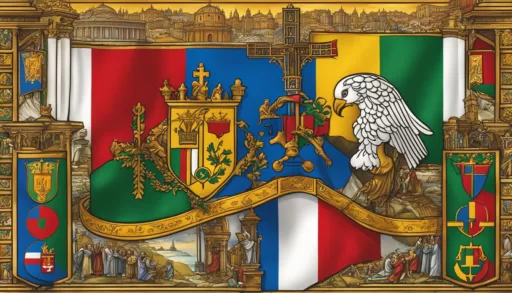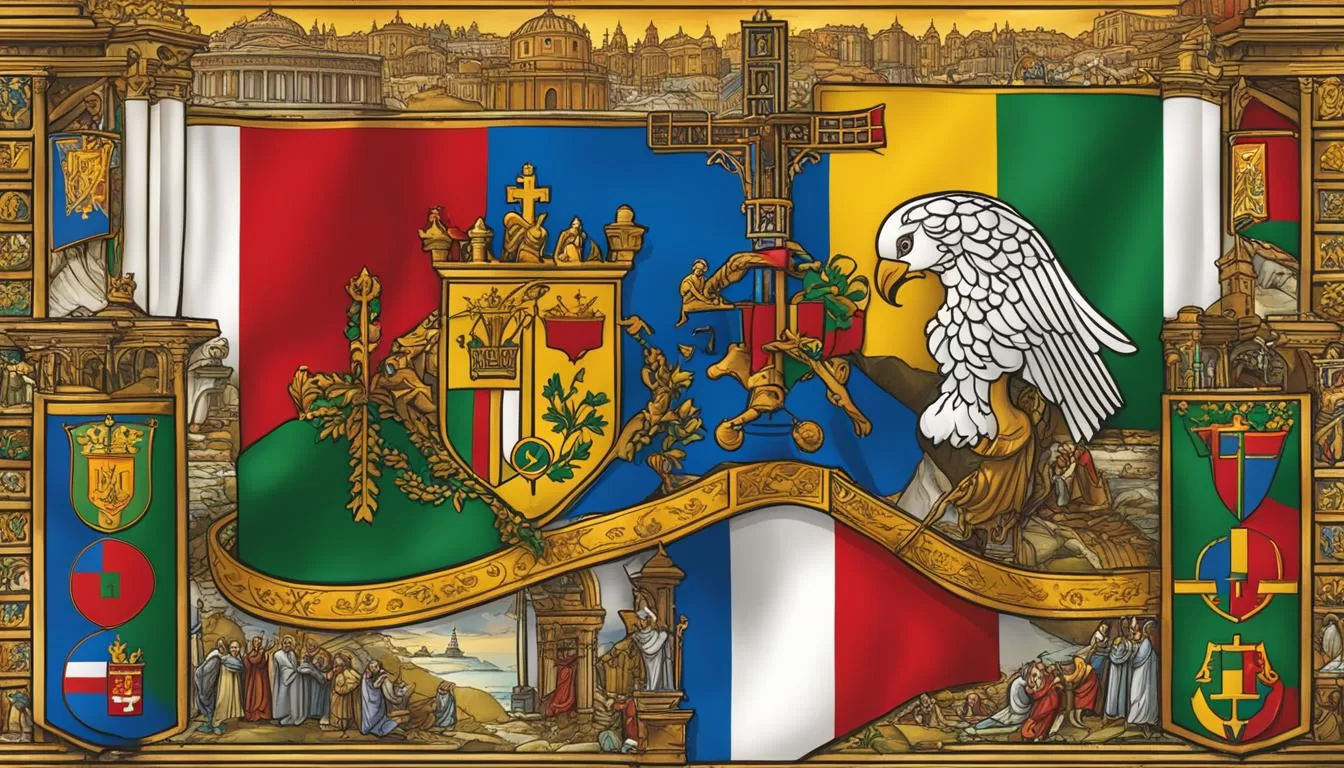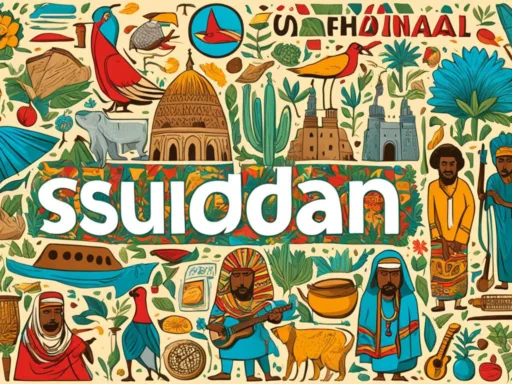The languages spoken in the Holy See and within the enigmatic boundaries of Vatican City offer a fascinating glimpse into the rich tapestry of cultural and historical narratives that define this unique sovereignty. At the forefront of the official languages of the Holy See lie Italian and Latin, languages steeped in historical resolve and present-day practicality. Italian, with its melodious cadence, serves as the principal channel of communication, weaving through daily affairs, administrative operations, and the conveyance of papal teachings. Meanwhile, Latin, the bedrock of ecclesiastical heritage, continues to resound within the hallowed walls of the Vatican, enshrining religious rituals and the venerable traditions of the Church.
The Holy See’s reverence for linguistic tradition is matched only by its embrace of diversity. It is a place where clerical discourse and daily colloquy echo the multitude of languages in Vatican City, reflecting a congregation that transcends borders. A realm where the universal pulse of Catholicism harmoniously blends with the multilingual profusion of its devout fellowship.
Key Takeaways
- Italian remains the predominant language for administration and official documentation in the Holy See.
- Latin sustains its esteemed role in ecclesiastical traditions and liturgies.
- The linguistic landscape of Vatican City reflects a convergence of global cultures.
- French and German languages underscore the diplomatic and international relations of the Vatican.
- The diverse languages spoken within the Holy See honor the Catholic Church’s expansive demographic.
- Official languages serve as a bridge between the Vatican’s historic roots and its contemporary global influence.
Linguistic Heritage of the Holy See
Tracing the evolution of language within Vatican City unveils a rich narrative that intertwines solemn tradition and dynamic cultural shifts, revealing the intricate fabric of linguistic diversity in the Holy See. This linguistic journey not only reflects the deep-seated heritage of the ecclesiastical state but also showcases the Holy See’s language policy, which embraces both ancient scripture and contemporary diplomacy.
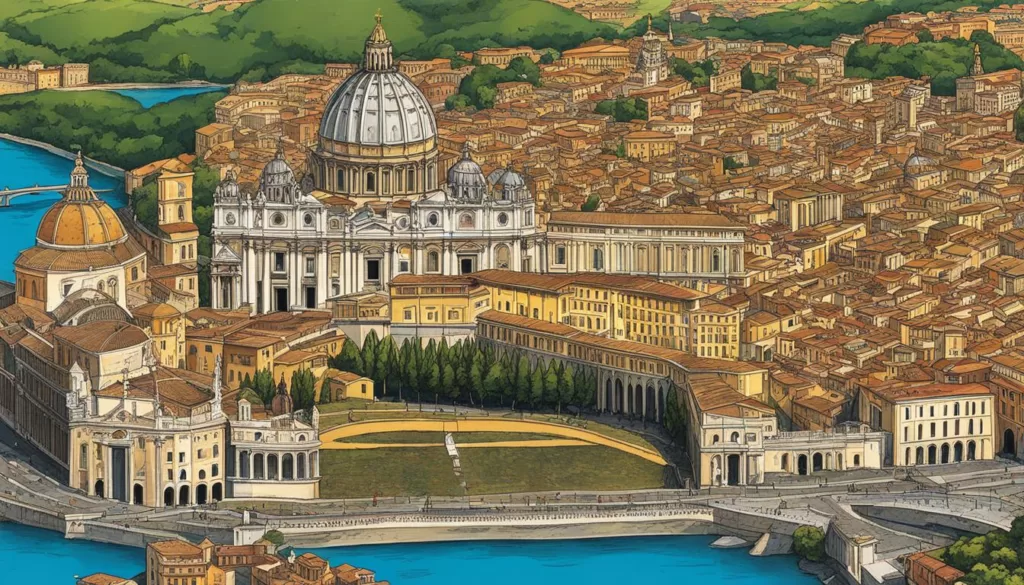
Historical Evolution of Languages in the Vatican
From its foundation, the language landscape of Vatican City has been profoundly shaped by its historical context. The Latin language, once the vernacular of the Roman Empire and thereby the bedrock of Vatican communication, was preserved through the ages within the towering structures and ageless inscriptions of the city. The harmonious transition from referring to intimate communications of daily life to a sacred symbol of universal Catholic teachings has made Latin an enduring emblem of language diversity in Vatican City.
Role of the Latin Language in Ecclesiastical Affairs
Despite the rise of vernacular languages, Latin remains an indestructible pillar within the Holy See, standing firm amidst the ebb and flow of linguistic tastes. The sanctity of Latin within ecclesiastical documents and liturgical ceremonies is a testament to the time-honored status it possesses, reflecting a continuous strand of linguistic diversity within the Holy See. This ancient language, symbolic of an unbroken lineage of papal authority, continues to resonate within the halls of the Vatican, echoing the eternal nature of the Church’s mission.
Influence of Italian on Vatican City’s Linguistic Identity
Transitioning into the modern era, Italian has emerged as a vital cog within the machinery of the Vatican’s everyday affairs. The adoption of Italian, marked officially during the 2014 Synod of Bishops when it supplanted Latin, was cemented further by the Lateran Treaty of 1929 that formally recognized Vatican City as an independent state. This significant event was pivotal in shaping the language policy of the Holy See, situating Italian at the core of legislative, administrative, and diplomatic exchanges. The strategic placement of Italian as the principal language for Vatican City’s laws and official publications underscores its influential role in shaping the Vatican’s linguistic identity.
In exploring the linguistic diversity of the Holy See, one observes the delicate balance between preserving the solemn antiquity of Latin and embracing the practicality of Italian, a dance of tradition and modernity that continues to enrich the Vatican’s spiritual and temporal realms.
The Role of Italian as the Lingua Franca
Within the microcosmic nation of Vatican City, a bastion of Vatican City multilingualism pervades, yet Italian proudly holds dominion as the indisputable lingua franca. The ubiquity of Italian’s melodic syllables in Vatican City is not merely by chance but by a longstanding tradition and practicality, shaping its role as the conduit for Vatican City’s official documents and the bearer of messages encapsulated in Papal encyclicals.
The harmonious interplay between the dignified presence of various tongues and the prevalence of Italian echoes the Holy See’s commitment to accessibility and communication with the world. Whether it’s in the intricate dealings of state affairs or the spiritual guidance issued from the papal seat, Italian serves as the mainstay among the languages, ensuring clear understanding and cohesive operation amidst Vatican City’s intricacies.
In the day-to-day conversations swirling through the Vatican’s cobblestone lanes to the hushed whispers within the Apostolic Palace, Italian resonates, unifying the denizens and pilgrims alike. This functional yet poetic tongue acts as a bridge spanning the sacred liturgy and the bustling modern life that coexists within the Vatican’s hallowed confines.
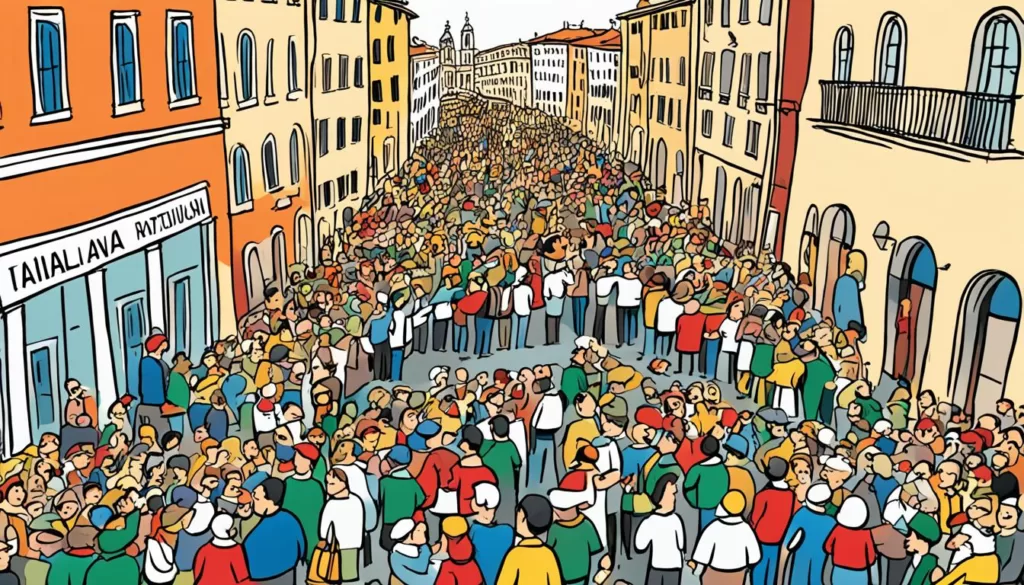
It is beneath the Italian language’s embrace that the Vatican’s mission proliferates, connecting an array of individuals from across the globe. The presence of Italian in every facet of Vatican City’s life is a testament to its role in fostering Vatican City’s cultural reputation as a hub of international exchange and ecclesiastical leadership.
The following table highlights the critical functions of Italian in the daily life and administration of the Vatican:
| Function | Role of Italian |
|---|---|
| Administration | Primary language for official communication |
| Documentation | Language for issuing official documents and decrees |
| Liturgy | Used alongside Latin in religious services and publications |
| Diplomacy | Facilitates communication in international affairs |
| Education | Medium of instruction in Vatican education channels |
| Day-to-Day Interactions | Cultivating a shared understanding among Vatican City residents and visitors |
The entrenchment of Italian within Vatican City underscores its invaluable significance as not just a vehicle for governance and faith but as a cornerstone of Vatican identity—a reflection of a past rich with history and a current state bustling with a confluence of global influences.
Official Languages of the Holy See: Italian and Latin
Within the hallowed grounds of Vatican City, a profound linguistic duality permeates every aspect of the Holy See’s governance and sacred rituals. As the custodian of Catholic tradition and a global religious leader, the Vatican embraces Italian and Latin as its official languages. These languages embody the dual spirit of the Vatican’s past and present, reflecting a continuum from historic scripture to contemporary international dialogue. The official documents of the Holy See, nestled within the ancient and resolute walls, are predominantly articulated in Italian, a testament to the language’s practical omnipresence in administrative and daily affairs.
Italian in the Vatican’s Administration and Daily Use
The hub of the Vatican’s multifaceted operations, Italian holds the keys as the central channel of communication. Affixed firmly to the foundation of the Vatican’s administrative framework, Italian courses through the veins of this ecclesiastical sovereign entity, facilitating effective governance and becoming synonymous with the Holy See’s day-to-day function. The adornment of Vatican’s official documents in the Italian language underscores its prime role in guiding the faithful and marking historic papal pronouncements. Catering to a plethora of pilgrims and diplomats alike, Italian serves not only as a medium of instruction and diplomacy but also as the essence of Vatican’s linguistic identity.
Enduring Significance of Latin within Church Documents
Defiant in the face of time’s transformative tides, Latin, revered as Ecclesiastical Latin, continues to sit at the core of the Church’s most hallowed documents and liturgies. In the solemn sanctuaries and during the most intricate and spiritual Vatican’s liturgies, Latin’s echoes encapsulate an unwavering link to tradition and heritage. This ancient tongue, once the heartbeat of a vast empire, has been devoutly preserved as the lexicon of canon law and theological discourse—providing a window into the sacred and the divine. Latin, resilient and majestic, imparts an immutable sense of continuity, anchoring the Church’s teachings to its apostolic origins.
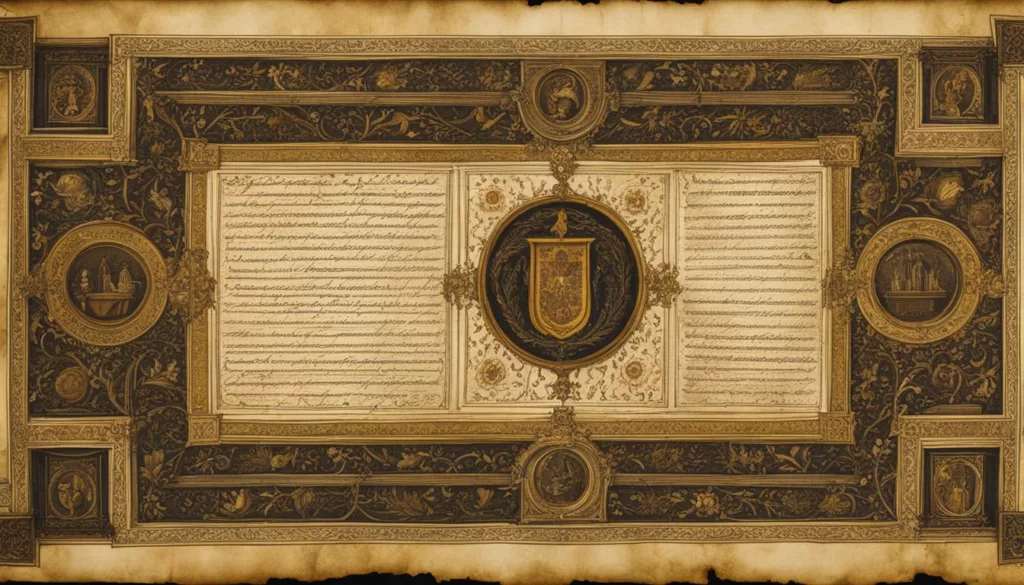
The Vatican’s linguistic heritage, with a focus on Italian and Latin as official languages, is not merely a reflection of history but a living, breathing element of the Holy See’s global persona. As we delve deeper into the linguistic enclaves of the Vatican, we find these classical languages not simply surviving, but thriving—forging connections, conveying divine law, and exemplifying the enduring power of tradition amidst the relentless march of modernity.
Languages Spoken in the Holy See: Multilingualism and Diplomacy
The linguistic landscape of the Holy See is a testament to its historical significance and its current role on the world stage. The fabric of spoken languages within Vatican City and its governing body, the Holy See, encompasses not just Italian and Latin but also extends to German, Polish, Spanish, and Romansh. This multilingual diversity underlines the global outreach of the Catholic Church and the complex nature of diplomatic communications.
In the realm of international ecclesiastical diplomacy, French serves as a diplomatic language frequently used in dialogue with states and international organisations. Its use is a reflection of the Holy See’s intricate engagement in global affairs beyond its spiritual mission, and it supports the legacy of French as a long-standing medium in diplomatic circles.
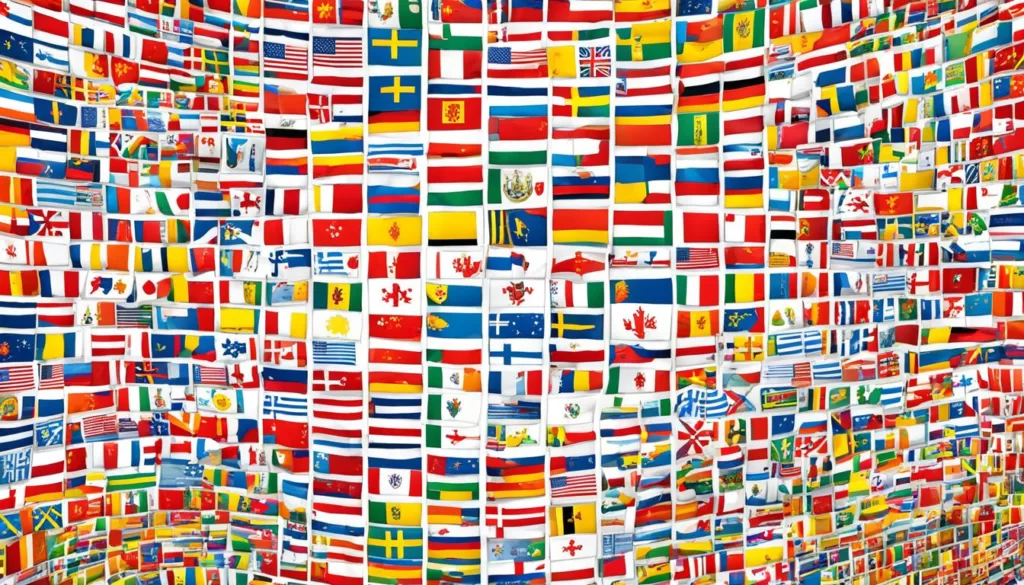
German, Polish, and Spanish are among the languages spoken in the Holy See, reflecting the nationalities and cultural backgrounds of the residents within Vatican City. The Swiss Guard, guardians of the Pope, famously issue commands in Swiss German, yet take their solemn oaths in their native languages. The Polish language gained prominence during the papacy of John Paul II, while Spanish is widely spoken due to the vast number of Spanish-speaking Catholics worldwide.
These various tongues not only contribute to the cacophony of voices within the Vatican’s walls but also illustrate the linguistic landscape of the Holy See in its dealings with the faithful and the global community.
The following table details how different languages, including French as a diplomatic language, serve various functions within the Vatican:
| Language | Function within the Holy See |
|---|---|
| Italian | Main administrative and communicative language |
| Latin | Used in liturgical services and official church documents |
| French | Often used for diplomatic negotiations and relations |
| German | Utilized by the Swiss Guard and for some scholarly texts |
| Polish | Historical significance during John Paul II’s papacy and among the Polish faithful |
| Romansh | Part of the Swiss Guard’s cultural heritage |
| Spanish | Commonly used due to the large Spanish-speaking Catholic population |
Ultimately, the use of multiple languages, with Italian at its core, facilitates the Holy See’s mission of universal outreach. Linguistic adaptability within the Holy See ensures that the message of the Church transcends linguistic barriers, nurturing an environment where faith and diplomacy converge.
The Papacy’s Linguistic Reach: From Local to Global
The leadership of the Holy See has historically maintained a rich, polyglot heritage, which has reinforced its role as the bedrock of the global Catholic Church. As the smallest sovereign state, Vatican City epitomizes the interconnection of faith and culture through the prism of language. The historical diversity in the native tongues of the popes themselves points to an enduring tradition of linguistic inclusion, elucidating the evolution of the Papal States and its modern-day manifestations. The multilingual nature of the papacy embodies Vatican City’s international relations, showcasing an ecclesiastical entity that is as global as it is local.
The Polyglot Nature of the Papal States
Over the centuries, the Papal States have served as a tapestry wrought with diverse modern tongues, each chapter of its history shaded by the linguistic backgrounds of its leaders. The native languages of the popes have alternated among Italian, German, Polish, and Spanish, painting a vivid picture of a papacy that is not bound by geographical confines. This diverse linguistic tradition not only speaks to the inclusive nature of the Church but also to its adaptive strategies in fostering relationships across myriad cultures and nations.
Modern Popes and Their Native Languages
The contemporary era of the papacy has continued to reflect this polyglot mosaic. Each pope arrives bearing the linguistic heritage of their homeland – contributing to the Vatican’s reputation as a beacon of the global Catholic Church. From Pope John Paul II’s influential Polish to Pope Francis’s engaging Spanish, every pontiff has enlivened Vatican City with layers of linguistic depth. These linguistic dimensions have strengthened the fabric of Vatican City’s international relations, amplifying the Holy See’s outreach and affirming the power of communication in bridging cultural divides within the universal church.
FAQ
What languages are spoken in the Holy See?
The Holy See is known for its linguistic heritage, with Latin as its official language. Italian is widely spoken and utilized for administrative and daily functions, including official documents. Other languages spoken include German, Polish, French, Spanish, and indigenous Romansh due to its linguistically diverse population.
Can you tell me about the linguistic heritage of the Holy See?
The Holy See’s linguistic heritage is deeply rooted in history. Latin, once the everyday language of the Roman Empire and the Papal States, still holds ecclesiastical significance. Italian emerged following the Lateran Treaty of 1929 and the 2014 Synod of Bishops as the primary language for laws and official publishing, showcasing the evolution of Vatican City’s linguistic identity.
What role does Latin play in ecclesiastical affairs?
Latin remains essential in the Catholic Church, utilized in official documents, liturgies, and ceremonies. It is prominent in ecclesiastical affairs, reflecting the Church’s dedication to maintaining its historical and cultural traditions.
How has Italian influenced Vatican City’s linguistic identity?
Italian has had a significant influence on Vatican City’s linguistic identity. It serves as the primary language for administrative purposes, laws, and official communications, including papal encyclicals. Italian has replaced Latin in many aspects of daily life within Vatican City but remains secondary in ecclesiastical contexts.
What is the role of Italian as the lingua franca in Vatican City?
Italian is the lingua franca of Vatican City, used in administrative matters and daily interactions within the Holy See. From official documents to casual conversations among residents, Italian is the predominant language for communication.
Are both Italian and Latin official languages of the Holy See?
Yes, the Holy See recognizes both Italian and Latin as official languages. Italian is used predominantly for administrative functions and daily communication, whereas Latin holds significance in ecclesiastical contexts and is used in Church documents and liturgies.
How is Italian employed in the Vatican’s administration and daily use?
Italian is the main language for administration within the Vatican City’s governmental apparatus. It is also the language primarily used for everyday communication among the Holy See’s residents and staff.
Does Latin still hold significance within Church documents?
Absolutely. Despite Italian being the language for administration, Latin continues to carry enduring significance within the church. It is extensively used in official Church documents, papal encyclicals, and Vatican liturgies, preserving its historical place in ecclesiastical tradition.
How does multilingualism and diplomacy manifest in the languages spoken in the Holy See?
The Holy See exhibits remarkable linguistic diversity, with a multilingual fabric lending itself to various international communications and diplomatic relations. French is often used as the language of diplomacy within the Holy See, reflecting its extensive global interactions.
What does the polyglot nature of the Papal States reveal about the papacy’s linguistic reach?
The Papal States’ polyglot nature highlights a history of linguistic diversity and adaptability. Past popes have brought with them languages such as Italian, German, Polish, and Spanish, showcasing an openness and global reach that continues to resonate in the Holy See’s engagement with the international community.
How do modern popes and their native languages contribute to the Church’s global influence?
Modern popes, hailing from various countries and speaking different languages, contribute to the Church’s global influence by transcending cultural and linguistic barriers. Their ability to communicate in diverse modern tongues aids in fostering international relations and connecting with a worldwide congregation.
